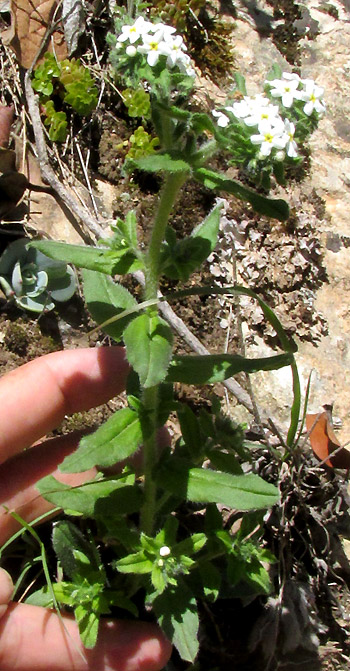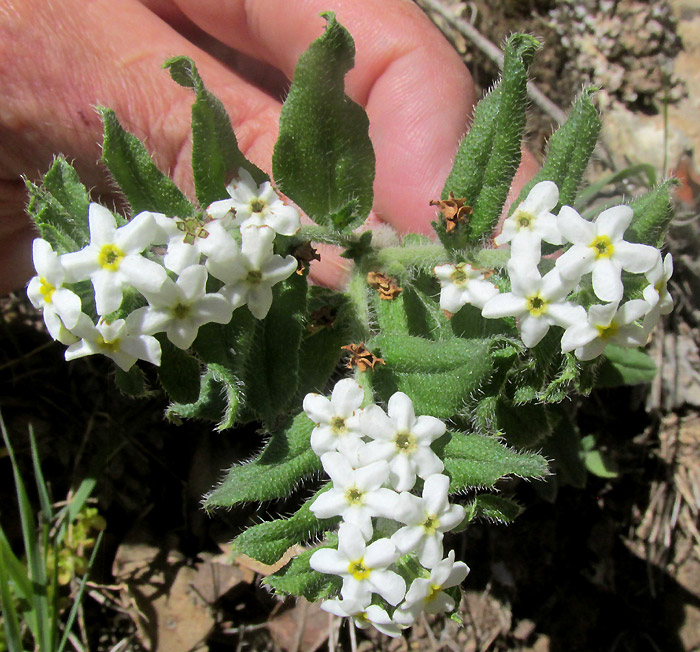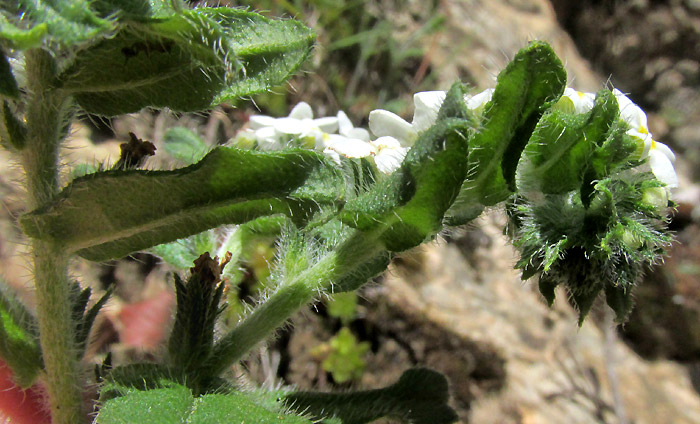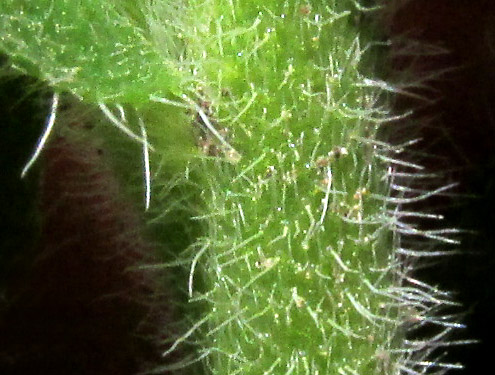Excerpts from Jim Conrad's
Naturalist Newsletter
Entry from field notes dated September 3, 2023, taken in Los Mármoles National Park in the Eastern Sierra Madre mountains, Hidalgo state, MÉXICO; oak-pine forested mountain, on road leading to Puerto de Piedra, which branches off the road between Trancas {on maps designated "Morelos (Trancas)"} and Nicolás Flores; limestone bedrock; elevation ~2,550m (~8,350); N20.811°, W99.219°
HELIOTROPE, EUPLOCA FOLIOSISSIMA
 In intense morning sunlight the wildflower at the right occupied the south-facing wall of an old roadcut into a steep slope. During a continuing, long-term drought, clusters of springy looking white flowers atop the plant looked out of place in the parched landscape. The flowers were gathered into three separate clusters. Some leaves were arranged in pairs along the stem, but others arose singly. Note that at the plant's bottom young sprouts were emerging with white flower-buds at their centers; the plant was vigorously branching from its base, probably to become somewhat bushy later. Here's a shot from above showing the three flower clusters:
In intense morning sunlight the wildflower at the right occupied the south-facing wall of an old roadcut into a steep slope. During a continuing, long-term drought, clusters of springy looking white flowers atop the plant looked out of place in the parched landscape. The flowers were gathered into three separate clusters. Some leaves were arranged in pairs along the stem, but others arose singly. Note that at the plant's bottom young sprouts were emerging with white flower-buds at their centers; the plant was vigorously branching from its base, probably to become somewhat bushy later. Here's a shot from above showing the three flower clusters:

Already anyone familiar with local wildflowers and garden flowers may recognize a familiar kind of blossom and blossom arrangement. Notice that the outside tips of each inflorescence branch shows corollas dipping downward, as if the branch is curling under. A view of one branch from the side confirms this:

The small flowers are tightly lined up along the upper side of cyme-type inflorescence branch. Cymes consist of flowers held in somewhat flat-topped clusters along a primary axis on which the first flower to open has at its base another stem segment with a flower that opens later, and then another segment with another flower, on an on. Above, the first flower to blossom was on the cluster's left side. As the stem grew with more flowers, each flower at its time opened. On the right in the picture, the stem curls downward and underneath itself, its tip bearing immature flower buds. This is a special kind of cyme known as a scorpioid cyme, and it's absolutely typical among the forget-me-nots, genus Heliotropium. Another example is seen on the common Scorpion Tail, which produces similar flowers and inflorescences, but has a different growing habit. In the above picture, also note that leaf bases bear no petioles and blade bases can be somewhat squared.

A major feature of this plant's leaves and stems is that they are thickly covered with long, erect hairs, as seen at the right. Note that the hairs are of two lengths; short, broad-based hairs bending close to the body's surface, and much longer hairs extending away from the surface.
Being so sure that this was another species of heliotrope, genus Heliotropium of the Borage or Forget-Me-Not Family, the Boraginaceae, with technical literature available for identifying heliotropes in this part of Mexico, our plant was easily identified -- especially because of its thick covering of long hairs and leaves without petioles -- as Heliotropium foliosissimum. However, Kew's Plants of the World Database and other authoritative international sources say that our plant has been reassigned to another genus; now it's known as EUPLOCA FOLIOSISSIMA. In English, however, species of Euploca are still known as heliotropes or forget-me-nots.
Euploca foliosissima is endemic just to the highlands of central Mexico, from San Luis Potosí in the north south to Oaxaca. It doesn't appear to be common. In the comprehensive 2021 study by José Luis Villaseñor and others entitled "Riqueza y distribución de la flora vascular del estado de Hidalgo, México, our plant is not listed either as a Heliotropium or a Euploca, though we're at the western edge of its known distribution.
Because our plant is so poorly documented, I hesitated to accept the name. However, after viewing images of all Heliotropum and Euploca species documented for Hidalgo, none appeared to more closely resemble our plant than the Internet image of Euploca foliosissima known as L.C. Smith #627, which is the original type specimen on the herbarium sheet on which the species name is based. The combination of dense, long hairs, leaf shape and vigorous branching from the base clinches it for me.
Surely because of the species' scarcity I find no information about human uses of our plant. However, we don't forget the many uses any plant affords to the ecosystem in general, in this case especially for the moths, flies and bees known to pollinate forget-me-not flowers of all kinds.
However, science finds our plant very interesting, particularly in an evolutionary sense. Euploca foliosissima is one of relatively few non-grass species who has evolved the C4 carbon fixation process for photosynthesis. Only about 3% of all terrestrial plant species use the C4 pathway, the rest using C3, which the first plants used exclusively. Most C4 today are monocots, like grasses, especially those in dry, hot environments.
However, according to Rowan Sage's 2016 work "A portrait of the C4 photosynthetic family on the 50th anniversary of its discovery: species number, evolutionary lineages, and Hall of Fame," the genetic change leading to C4 photosynthesis has evolved on up to 61 independent occasions in 19 different families of plants, making it a classic example of convergent evolution. Using C4 photosynthesis instead of the normal C3 is a prime reason why numerous Heliotropum species, have been shifted to the genus Euploca, leaving behind C3 as Heliotropum. However, not all Euploca species are C4, and some are intermediate C4 and C3. That's one reason species of Euploca are so interesting. If it can be understood what's behind this situation, it may offer insights into fundamental questions about how biological evolution in general takes place.
Unfortunately for us who like to keep our plant names straight, this C4 difference doesn't much show in a plant's general appearance. Heliotropum species look practically the same as Euploca species.
With regard to our Euploca foliosissima itself, a further curiosity is that, according to Michael Frohlich and others in the 2022 work "Molecular phylogenetics of Euploca (Boraginaceae): homoplasy in many characters, including the C4 photosynthetic pathway," our species "may be of hybrid origin; its chromosome number is 2n = 48, compared to its likely sister E. humilis that has 2n = 24." Instead of evolving slowly, our Euploca foliosissima species may have appeared instantly, thanks to a genetic malfunction.
For me personally, this is a good example of "The more you know, the more you see you don't know, and the more complex and ultimately mysterious the whole Universe appears to be."